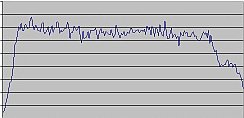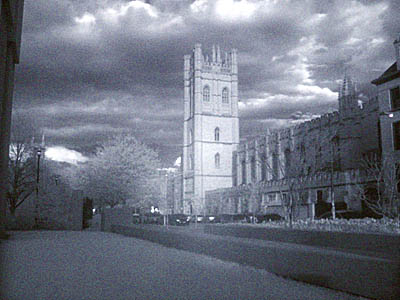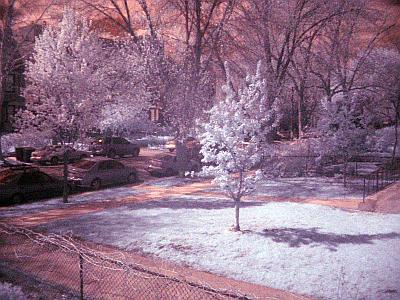Saturday, April 30, 2005
Ryerson office background radiation
Steven conveniently graphed the data from my geiger counter, covering a week in the Ryerson Astronomical Society office. http://gateway.spc.uchicago.edu/~stevenl/cosmic/
Thursday, April 28, 2005
Another airline plot
This was a trip to Las Vegas. Maximum altitude was at 39,000ft, and the flightpath was a relatively northern one across Nebraska and Colorado, then turned south in Utah. We flew for a while in southern Utah at a lower altitude while getting into the inbound approach, and you can see that on the graph.
http://www.lib.uchicago.edu/~dean/blog/mdwtolas.jpg

http://www.lib.uchicago.edu/~dean/blog/mdwtolas.jpg

Wednesday, April 27, 2005
more near-IR tests
I added a third layer of color negative to the filter, and this makes the sandwich completely opaque to the naked eye. The sun is barely visible (but not at all safe to look at) through it. I can get a reasonable if slightly underexposed image of open shaded areas with an exposure of 4 seconds at f/5.6 at ASA 400. With the third layer there is no difference between the red and blue filters, so I believe whatever I am getting is residual IR leakage.
http://www.lib.uchicago.edu/~dean/blog/reynoldsclub-ir.jpg

That isn't snow, it's grass.
A clue to what wavelengths we are seeing is the fact that the streetlight happened to be on, and we can see it, and HPS lights emit a very intense 819.3nm and 819.5nm doublet.
http://www.lib.uchicago.edu/~dean/blog/reynoldsclub-ir.jpg

That isn't snow, it's grass.
A clue to what wavelengths we are seeing is the fact that the streetlight happened to be on, and we can see it, and HPS lights emit a very intense 819.3nm and 819.5nm doublet.
Monday, April 25, 2005
near-IR world
http://www.lib.uchicago.edu/~dean/blog/ir1.jpg
http://www.lib.uchicago.edu/~dean/blog/ir2.jpg
http://www.lib.uchicago.edu/~dean/blog/ir-normal.jpg
These were shot with a near-IR filter over my camera
(a near infrared filter being two pieces of fully exposed color negative film).
If you swap the RGB colors around, you can eventually get something almost, but not quite entirely unlike, normal. http://www.lib.uchicago.edu/~dean/ir2-rgb-bgr.jpg
Some more (post-processing):
http://www.lib.uchicago.edu/~dean/blog/ir1-auto.jpg

http://www.lib.uchicago.edu/~dean/blog/ir2-colorswap.jpg
From looking at the RGB histograms out of the camera, it appears that the red and blue filters let the most near-IR through. Traditionally this is the case. The red lets very near-IR through, and the blue lets in IR at double the blue wavelength (a 450nm blue filter will let in 900nm IR, e.g.). The blue channel shows the most chlorophyll fluorescence too.
http://www.lib.uchicago.edu/~dean/blog/ir2.jpg
http://www.lib.uchicago.edu/~dean/blog/ir-normal.jpg
These were shot with a near-IR filter over my camera
(a near infrared filter being two pieces of fully exposed color negative film).
If you swap the RGB colors around, you can eventually get something almost, but not quite entirely unlike, normal. http://www.lib.uchicago.edu/~dean/ir2-rgb-bgr.jpg
Some more (post-processing):
http://www.lib.uchicago.edu/~dean/blog/ir1-auto.jpg

http://www.lib.uchicago.edu/~dean/blog/ir2-colorswap.jpg
From looking at the RGB histograms out of the camera, it appears that the red and blue filters let the most near-IR through. Traditionally this is the case. The red lets very near-IR through, and the blue lets in IR at double the blue wavelength (a 450nm blue filter will let in 900nm IR, e.g.). The blue channel shows the most chlorophyll fluorescence too.
Thursday, April 21, 2005
Lunar maria colors
A nice image of exaggerated maria colors on the Moon: http://www.rc-astro.com/img/moon_colors_2005-04-18_web.jpg.
Visually, you can see this, especially between Mare Serenitatis and Mare Tranquilatis (wow I can't believe I spelled that right the first time). They are the two prominent, quasi-circular touching maria on the left side. The color difference for maria basalts is the difference in composition of TiO2.
Tranquilatis, the bluer one, is very rich in TiO2.
Giguere, Thomas A.; Taylor, G. Jeffrey; Hawke, B. Ray; Lucey, Paul G.
The titanium contents of lunar mare basalts
Meteoritics & Planetary Science, vol. 35, no. 1, pp. 193-200 (2000).
Visually, you can see this, especially between Mare Serenitatis and Mare Tranquilatis (wow I can't believe I spelled that right the first time). They are the two prominent, quasi-circular touching maria on the left side. The color difference for maria basalts is the difference in composition of TiO2.
Tranquilatis, the bluer one, is very rich in TiO2.
Giguere, Thomas A.; Taylor, G. Jeffrey; Hawke, B. Ray; Lucey, Paul G.
The titanium contents of lunar mare basalts
Meteoritics & Planetary Science, vol. 35, no. 1, pp. 193-200 (2000).
Saturday, April 16, 2005
Another down
Another down. However, this rejection letter was very nice, as opposed to Arizona's. Mahalo, Hawaii.
Friday, April 15, 2005
I've been on vacation
I've been away. I didn't do much. I note that I heard many more stations in Nevada with an Icom R-71a in the 15 MHz and 17MHz broadcast bands than in Chicago. It probably proves that the old tube Hallicrafters S-40A needs work on stage 4, 15-40MHz. I heard Radio Netherlands on multiple frequencies, and it was neat to note one of the stations was 1/4 second behind the others. Steven and I have decided that proves it has 1 satellite hop extra to that relay station than the others. (Geosynchronous orbit is 23,000miles, roughly 1/8 light-second away). I bet stringing a simple wire out to the west edge of the roof (past the skylight) would give us a great signal and some immunity to the elevator noise. The current antennas, save for the magnetic one, aren't shielded and pick up noise (and signals too) from the coax braids, since they aren't correctly balanced.
Subscribe to:
Comments (Atom)